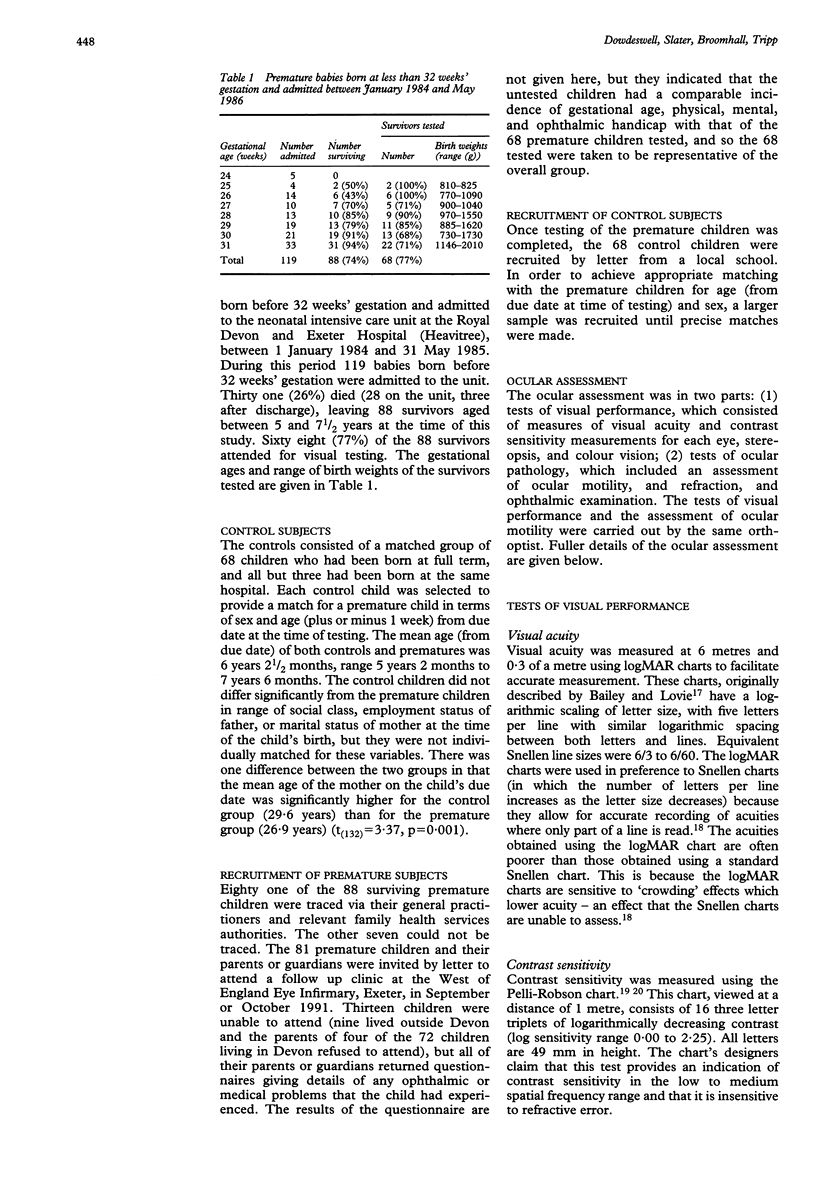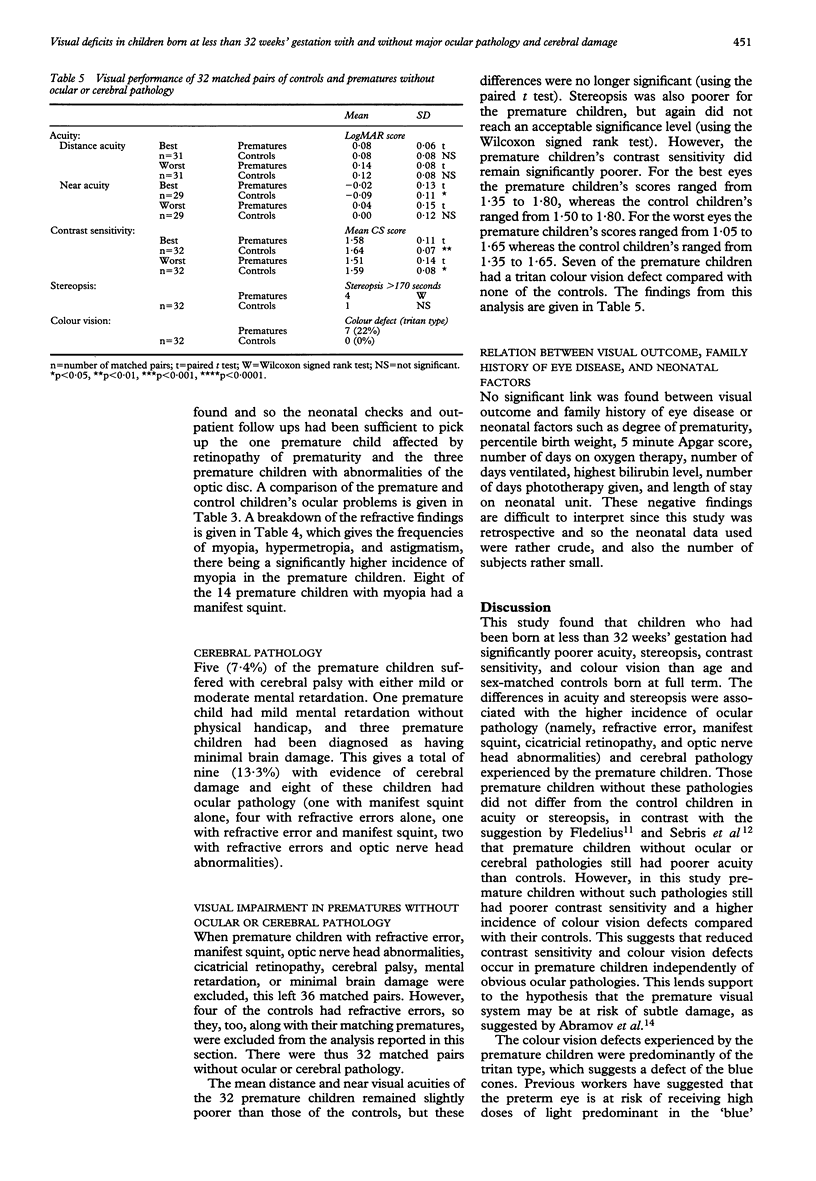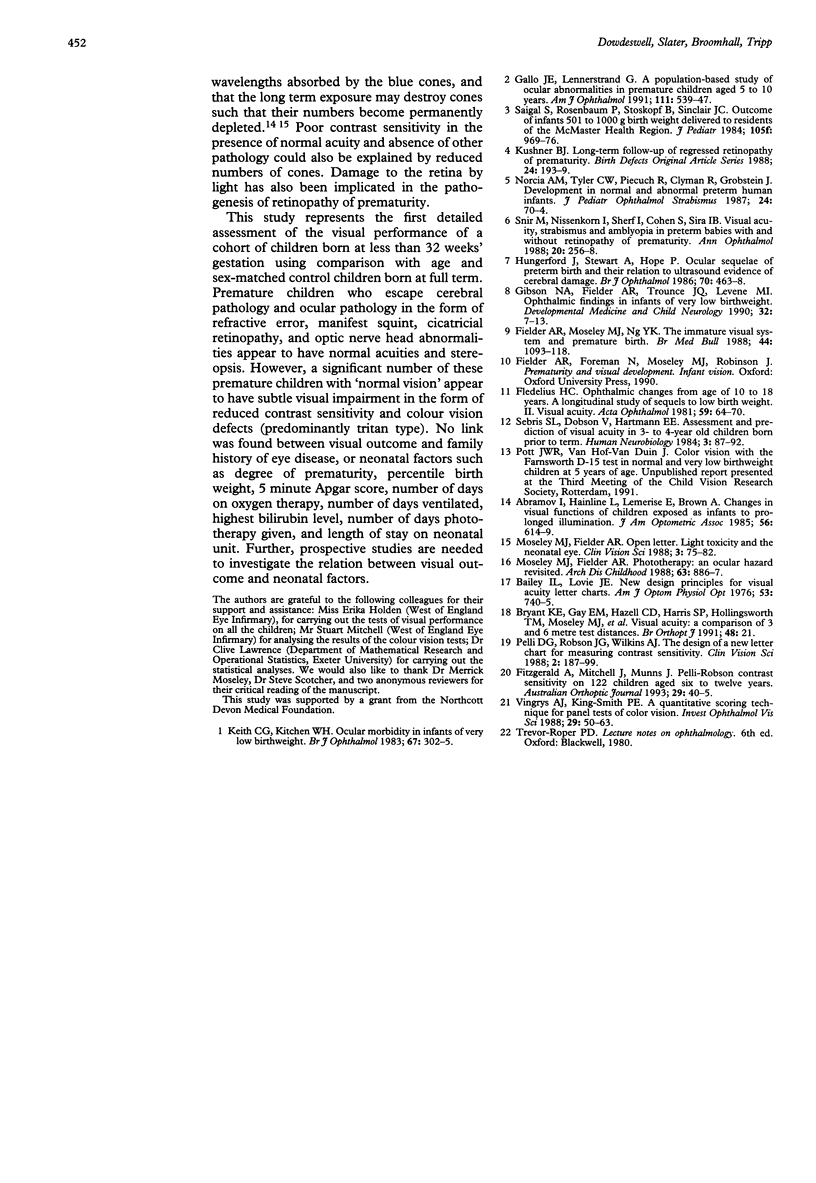Abstract
AIMS--A study was carried out to compare the visual abilities of prematurely born children with those of matched full term controls. METHODS--The vision of 68 children born at less than 32 weeks' gestation and aged between 5 and 7 1/2 years at the time of testing was compared with that of a control group of children born at full term, and matched for sex and age from due date. RESULTS--The premature children had significantly poorer distance and near visual acuity, contrast sensitivity and stereopsis, and a high incidence of colour vision defects (predominantly tritan type). These differences were associated with the high incidence of ocular pathology experienced by 31 (45%) of the premature children compared with only nine (13%) of the controls. When excluding children with ocular and cerebral pathology, 32 matched pairs of premature and control children remained. The 32 premature children did not differ from their controls in terms of distance and near acuities or stereopsis, but they did have significantly poor contrast sensitivity in both their 'best' and 'worst' eyes. None of the 32 control children had colour vision defects, compared with seven of the matched premature children. CONCLUSION--This adds support to previous speculation that the preterm eye is at risk of subtle visual impairment independent of the occurrence of refractive error, manifest squint, disorders of the fundus and media, and cerebral damage.
Full text
PDF





Selected References
These references are in PubMed. This may not be the complete list of references from this article.
- Abramov I., Hainline L., Lemerise E., Brown A. K. Changes in visual functions of children exposed as infants to prolonged illumination. J Am Optom Assoc. 1985 Aug;56(8):614–619. [PubMed] [Google Scholar]
- Bailey I. L., Lovie J. E. New design principles for visual acuity letter charts. Am J Optom Physiol Opt. 1976 Nov;53(11):740–745. doi: 10.1097/00006324-197611000-00006. [DOI] [PubMed] [Google Scholar]
- Fielder A. R., Moseley M. J., Ng Y. K. The immature visual system and premature birth. Br Med Bull. 1988 Oct;44(4):1093–1118. doi: 10.1093/oxfordjournals.bmb.a072291. [DOI] [PubMed] [Google Scholar]
- Fledelius H. C. Ophthalmic changes from age of 10 to 18 years. A longitudinal study of sequels to low birth weight. II. Visual acuity. Acta Ophthalmol (Copenh) 1981 Feb;59(1):64–70. doi: 10.1111/j.1755-3768.1981.tb06712.x. [DOI] [PubMed] [Google Scholar]
- Gallo J. E., Lennerstrand G. A population-based study of ocular abnormalities in premature children aged 5 to 10 years. Am J Ophthalmol. 1991 May 15;111(5):539–547. doi: 10.1016/s0002-9394(14)73695-5. [DOI] [PubMed] [Google Scholar]
- Gibson N. A., Fielder A. R., Trounce J. Q., Levene M. I. Ophthalmic findings in infants of very low birthweight. Dev Med Child Neurol. 1990 Jan;32(1):7–13. doi: 10.1111/j.1469-8749.1990.tb08461.x. [DOI] [PubMed] [Google Scholar]
- Hungerford J., Stewart A., Hope P. Ocular sequelae of preterm birth and their relation to ultrasound evidence of cerebral damage. Br J Ophthalmol. 1986 Jun;70(6):463–468. doi: 10.1136/bjo.70.6.463. [DOI] [PMC free article] [PubMed] [Google Scholar]
- Keith C. G., Kitchen W. H. Ocular morbidity in infants of very low birth weight. Br J Ophthalmol. 1983 May;67(5):302–305. doi: 10.1136/bjo.67.5.302. [DOI] [PMC free article] [PubMed] [Google Scholar]
- Kushner B. J. Long-term follow-up of regressed retinopathy of prematurity. Birth Defects Orig Artic Ser. 1988;24(1):193–199. [PubMed] [Google Scholar]
- Moseley M. J., Fielder A. R. Phototherapy: an ocular hazard revisited. Arch Dis Child. 1988 Aug;63(8):886–887. doi: 10.1136/adc.63.8.886. [DOI] [PMC free article] [PubMed] [Google Scholar]
- Saigal S., Rosenbaum P., Stoskopf B., Sinclair J. C. Outcome in infants 501 to 1000 gm birth weight delivered to residents of the McMaster Health Region. J Pediatr. 1984 Dec;105(6):969–976. doi: 10.1016/s0022-3476(84)80093-1. [DOI] [PubMed] [Google Scholar]
- Sebris S. L., Dobson V., Hartmann E. E. Assessment and prediction of visual acuity in 3- to 4-year-old children born prior to term. Hum Neurobiol. 1984;3(2):87–92. [PubMed] [Google Scholar]
- Snir M., Nissenkorn I., Sherf I., Cohen S., Ben Sira I. Visual acuity, strabismus, and amblyopia in premature babies with and without retinopathy of prematurity. Ann Ophthalmol. 1988 Jul;20(7):256–258. [PubMed] [Google Scholar]
- Vingrys A. J., King-Smith P. E. A quantitative scoring technique for panel tests of color vision. Invest Ophthalmol Vis Sci. 1988 Jan;29(1):50–63. [PubMed] [Google Scholar]


